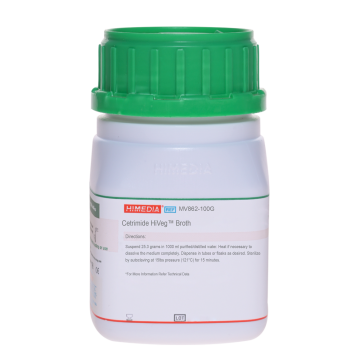 Your enquiry has been submitted
Your enquiry has been submitted
Malachite Green Broth
Pseudomonas aeruginosa#CC293D
Intended Use
Recommended for selective enrichment of Pseudomonas aeruginosa.
Composition**
| Ingredients | g/L |
|---|---|
| Peptone | 15.000 |
| HM extract # | 9.000 |
| Dipotassium hydrogen phosphate | 1.100 |
| Malachite green | 0.030 |
Final pH (at 25°C): 7.0±0.2
**Formula adjusted, standardized to suit performance parameters
# Equivalent to Meat extract
Directions
Suspend 25.13 grams in 1000 ml purified / distilled water. Heat if necessary to dissolve the medium completely. Dispense into tubes or flasks as desired. Sterilize by autoclaving at 15 lbs pressure (121°C) for 15 minutes.
Principle And Interpretation
Pseudomonas species is an environmental organism found in water and soil and on plants, including fruits and vegetables. Pseudomonas aeruginosa has the ability to survive in the aqueous environments like whirlpool bathwater, swimming pools etc (1). Whirlpools with elevated temperature, reduced chlorine and increased amounts of organic matter provide ideal conditions for the growth of P. aeruginosa. P.aeruginosa is commonly isolated from whirlpool waters that is coliform-negative(2). Malachite Green Broth is recommended for the selective enrichment of P. aeruginosa as per Habs and Kirschner (3). It is also used for testing water samples as recommended by Schubert and Blum (4).
HM extract and peptone serve as sources of essential nutrients required for bacterial metabolism. Dihydrogen potassium phosphate serves to buffer the medium. Malachite green makes the medium selective for P.aeruginosa while suppressing the growth of the accompanying flora. The medium can also be used as a single strength medium by suspending 8.4 g/litre of medium, depending upon the sample being tested.
Type of specimen
Water samples
Specimen Collection and Handling:
For water samples, follow appropriate techniques for sample collection, processing as per guidelines and local standards.(5)
After use, contaminated materials must be sterilized by autoclaving before discarding.
Warning and Precautions :
Read the label before opening the container. Wear protective gloves/protective clothing/eye protection/ face protection. Follow good microbiological lab practices while handling specimens and culture. Standard precautions as per established guidelines should be followed while handling specimens. Safety guidelines may be referred in individual safety data sheets.
Limitations :
- Further biochemical and serological tests must be carried out for further identification.
Performance and Evaluation
Performance of the medium is expected when used as per the direction on the label within the expiry period when stored at recommended temperature.
Quality Control
Appearance Light yellow to greenish yellow homogeneous free flowing powder
Colour and Clarity of prepared medium Peacock blue coloured clear solution without any precipitate
Reaction
Reaction of 2.51% w/v aqueous solution at 25°C. pH: 7.0±0.2
pH
6.80-7.20
Cultural Response
Cultural characteristics observed after an incubation at 35-37°C for 18-24 hours.
| Organism | Inoculum (CFU) | Growth |
|---|---|---|
| Escherichia coli ATCC 25922 (00013*) | >=104 | inhibited |
| Pseudomonas aeruginosa ATCC 27853 (00025*) | 50-100 | luxuriant |
Key: *Corresponding WDCM numbers.
Storage and Shelf Life
Store between 10-30°C in a tightly closed container and the prepared medium at 15-30°C. Use before expiry date on the label. On opening, product should be properly stored dry, after tightly capping the bottle in order to prevent lump formation due to the hygroscopic nature of the product. Improper storage of the product may lead to lump formation. Store in dry ventilated area protected from extremes of temperature and sources of ignition. Seal the container tightly after use. Product performance is best if used within stated expiry period.
Disposal
User must ensure safe disposal by autoclaving and/or incineration of used or unusable preparations of this product. Follow established laboratory procedures in disposing of infectious materials and material that comes into contact with sample must be decontaminated and disposed of in accordance with current laboratory techniques (6,7).
Reference
- Murray P. R., Baron J. H., Pfaller M. A., Jorgensen J. H. and Yolken R. H., (Eds.), 2003, Manual of Clinical Microbiology, 8th Ed., American Society for Microbiology, Washington, D.C.
- Hall N., 1984, UHL Lab Hotline 21: 9.
- Habs H. and Kirschner K. H, 1943, Z.Hyg., 124:557-578.
- Schubert R. and Blum U., 1974, Zbl. Bakt. Hyg .I. Orig. B.,158:583-587.
- Lipps WC, Braun-Howland EB, Baxter TE,eds. Standard methods for the Examination of Water and Wastewater, 24th ed. Washington DC:APHA Press; 2023.
- Isenberg, H.D. Clinical Microbiology Procedures Handbook 2nd Edition.
- Jorgensen, J.H., Pfaller, M.A., Carroll, K.C., Funke, G., Landry, M.L., Richter, S.S and Warnock., D.W. (2015) Manual of Clinical Microbiology, 11th Edition. Vol. 1.
| Product Name | Malachite Green Broth |
|---|---|
| SKU | M1266 |
| Product Type | Regular |
| Physical Form | Powder |
| Origin | Animal |
| Packaging type | HDPE |
| References | 1. Murray P. R., Baron J. H., Pfaller M. A., Jorgensen J. H. and Yolken R. H., (Eds.), 2003, Manual of Clinical Microbiology,8th Ed., American Society for Microbiology, Washington, D.C. ,, |
| Customized Product Available | No |






